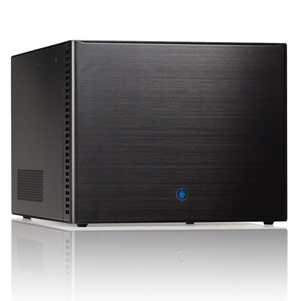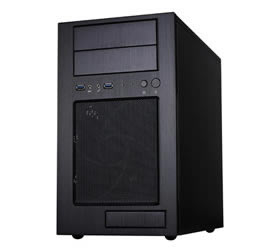File Server Builder's Guide
by Zach Throckmorton on September 4, 2011 3:30 PM ESTAs motherboard layout is important in ensuring that airflow is as unobstructed as possible, case design is also critical in facilitating excellent airflow. If you're building a system with one or two hard drives, most cases work fine for a home file server - just make sure there is a fan near the hard drive(s) so it is not sitting in stagnant air. However, if your server requires multiple disks, here are a few cases that work especially well for file servers.
Mini-ITX

Fractal's Array R2 is a nearly perfect home file server case. At less than 14" deep by 10" wide by 8" tall, it occupies little volume. It positions a removable hard drive cage immediately behind a quiet yet powerful 140mm intake fan. The hard drive cage accommodates up to six hard drives using vibration-dampening silicone mounts, and there is also room for a 2.5" drive (either an SSD or HDD). According to my testing, when stuffed with six low-rpm 2TB mass storage HDDs and one SSD (with an Intel Pentium G620 CPU installed), the temperatures of the HDDs hover around 40C even when all drives are under artificial sustained load (using Iometer). The PSU is a custom SFX form factor model, 80+ efficiency 300W unit with ample amps on the split 12V rail to power six HDDs. The PSU features seven SATA connectors and one legacy molex connector, so there are no extraneous molex plugs and enough SATA plugs. Furthermore, the cables are shorter than typical, so excessive cabling does not interfere with airflow. The case itself is constructed of aluminum so it is lightweight, and its overall build quality is very high. It does not have room for an optical drive, but I consider optical drives superfluous for a home file server. If necessary, you can always hook up a USB interface external optical drive. The only drawback of this case and its PSU is the price: at just under $200, it is not cheap. However, the subjective aesthetics, objective functionality of the case and the custom PSU are worth the cost if you want a small but capacious home file server case.
Micro-ATX

As I prefer home file servers that take up as little space as possible, Silverstone's TJ08B-E is a great, smaller micro-ATX minitower. It's less than 16" deep, 9" wide, 15" tall and weighs less than 12 pounds. It can accommodate up to five HDDs plus one SSD. As with the Fractal Array R2, the hard drives are placed immediately behind a front intake fan - though in this case, it's an even larger 180mm unit. The TJ08B-E is flexible in that it can hold a couple optical drives as well as a GPU in case you want to repurpose or multipurpose it. When stuffed with four low-rpm green drives, the temperatures under load don't exceed 45C during sustained transfers. Overall build quality is very good, like most Silverstone cases.
Silverstone makes a diminutive, fully modular PSU that makes working with smaller cases like the TJ08B-E, Lian Li PC-Q08, and others much easier. Silverstone also offers a short cable kit, making the ST50F-P PSU even better suited to SFF cases. Finally, it's clear that Silverstone had smaller multi-HDD systems in mind when designing the CP06 SATA power plug extension cable. This extender connects to a single SATA power plug and then has four SATA power plugs that are spaced closer than usual together, further reducing cable clutter. Though the cost of these accessories adds up, they make an ideal cabling solution very easy to implement. Regardless of whatever PSU you decide to go with, if you use a split 12V rail model, make sure you don't load up one rail with HDDs. If you go with a single 12V rail model, you'll want that rail to be beefy - for example, don't try to put ten HDDs and four case fans on a budget PSU with a 20A 12V rail.
Full Tower
Very few cases can accommodate ten HDDs at stock (without adding adapters), and such cases are not at all small. Full towers also typically offer excellent airflow, and cable management is not very difficult. Fractal's Define XL is one of the least expensive 10 HDD bay full tower cases available. It is well-built, and extra care has been paid to making the case quiet in the form of panel insulation. It is impossible to hear active HDDs inside this case even when you're sitting just a few feet from it (even the notoriously loud VelociRaptors). Further, there are plenty of integrated niceties like adjustable/flexible cable baffles that assist in cable management. Seven of the ten HDD slots are immediately behind fans, with three slots one cage removed from the front intake fans. Even still, the HDDs that aren't right behind the fans stay cool (between 35C and 40C). At around $150, it is an excellent value. Just make sure you don't pair it up with Silverstone's short cable kit!
We've saved the most important aspect of a home file server - the hard drives - for the next and last component page.











152 Comments
View All Comments
masterbm - Thursday, September 8, 2011 - link
If was to build to today I would think about uses i3 or low-end i5 sandy-bridge. The cpu was pick because at the time I thought it was the best bang for the bang for what I need it for. The machine has not let my down yet. My back file server ie older media center box houses the old drives from increase the need for more space. The 750 has stayed because it has the size needed to handle is responsibility/. All drive have certain things that hold and when it get filled it is upgraded.MartenKL - Monday, September 12, 2011 - link
I would like my WHS2011 do realtime transcode of 1080p streams with 5.1 channel sound to my xboxes and ps3. Would the 2500T suffice?noxplague - Sunday, October 2, 2011 - link
First, I think most of these comments became focused on SMB/Midmarket type concerns. This guide was clearly aimed on the pro-sumer looking to solve his data proliferation issues. Not everyone needs enterprise style RAID.With the help of this guide I build the following WHS 2011:
Fractal Design Array R2 Black Aluminum Mini-ITX Desktop Computer Case 300W SFX PSU
Foxconn H67S LGA 1155 Intel H67 HDMI SATA 6Gb/s Mini ITX
Intel Pentium G620 Sandy Bridge 2.6GHz
2 X HITACHI Deskstar 7K3000 2TB 7200 RPM 64MB Cache SATA 6.0Gb/s 3.5" (RAID1)
Kingston HyperX 4GB (2 x 2GB) 240-Pin DDR3 SDRAM DDR3
Here are some of the scenarios I have enabled with this build:
Adobe Lightroom 3 on a Mac and on 2 PCs - this is really handy because I can store all photos on the server and have the library on each computer link to the 1 version of the truth. The only limitation is I cannot edit photos on the road that are back on the server.
iTunes - I have an Apple TV and iPad, carefully configuring iTunes on the server and on my clients I am able to download to have files on the server and still sync/stream everything to my different devices.
Zune & WP7 - ditto the above. I need to solve the album art issues across all of these devices however.
Mac - They have no problem accessing the files and RDC works just as well as on Windows.
Current problem: The only scenario that isn't working well is playing any WMV from the server. The "streaming" is painfully slow. This does not make sense to me because Quicktime videos on the server play on the Macs without a problem over wifi. Movie streaming to the Apple TV is seamless as well.
My server is connected to my Apple Airport extreme (4th generation) via Gigabit ethernet.
I found the guide helpful in finding good parts, in particular the case. I wish more time had been spent on scenarios and use cases with the server. Also the HDD section was useless. What would be much more practical would be advise on a decent setup. I decided to use the Intel RAID 1 with identical drives, but I have lots of questions about how to best maintain these and also the best way to consider adding new drives when needed. I'm trying to figure out an automated way to monitor the SMART status and have my server e-mail me if any drive has an issue. An brief overview of different backup methodologies would've been useful as well. Another useful discussion would be on UPS systems and how to configure your server to power down in the case of power loss.
Thanks for the guide and hope to see more on this topic in the future!
pacomcfriendly - Saturday, October 15, 2011 - link
This has been the best OS experience I've found for my own home fileserver. Its built on opensolaris, super easy to work with, free, and zfs / zpool is fantastic.wiz329 - Saturday, December 10, 2011 - link
This is a very beginner question, but what is the best way to access such a file server over the internet?I am looking to either use NAS or build such a home file server to store media. Over LAN, it seems pretty straightforward, just connect to your router. How would you go about accessing/streaming over WAN?
marcus77 - Saturday, October 6, 2012 - link
euroNAS would be also worth looking. They are offering storage software that is more for business use but they also offer technical assistance which is nessesary if something goes wrong. Also they have some advanced features such as storage cluster. http://www.euronas.comAmar7 - Monday, December 3, 2012 - link
Mr. Throckmorton,Great File Server Build Guide... Any update to hardware suggestions? Some of the parts are no longer available. Would love some ideas on a budget home file server.
Much thanks.
buxe2quec - Friday, December 7, 2012 - link
I would put in the list of possible operating systems also NexentaStor, it'a a very polished OpenSolaris/Illumos based NAS distribution free for personal use.war59312 - Monday, December 10, 2012 - link
Would love a 2012 update for this guide?StoatWarbler - Tuesday, October 22, 2013 - link
I'd love to see a 2013 update, especially for tower cases which can take a bunch of hotswap drive racks (My current ZFS array has 20 2Tb drives + 2 SSDs + OS drives. Yes, I'm barking mad and I enjoy it.)Why hotswap? Because opening a case to retrieve a failed drive is troublesome (case has to have access cleared to it, risk of pulling wrong drive on a running system, etc.)
On the subject of controllers: A good HBA (and SAS expander) are far better than using hardware raid controllers. Modern PCs have more than enough horsepower to push checksum calculations and it means that drives are portable between controllers.
I know about the cube cases out there such as Lian Li's D8000 - but afaik this doesn't allow for hotswap drives.